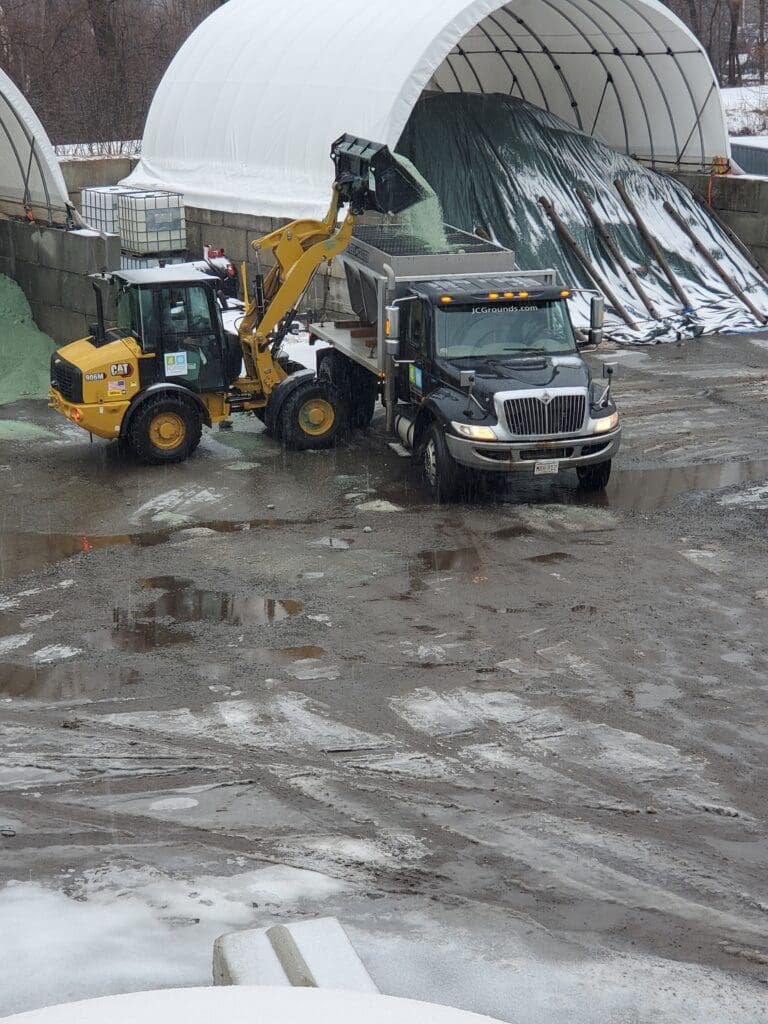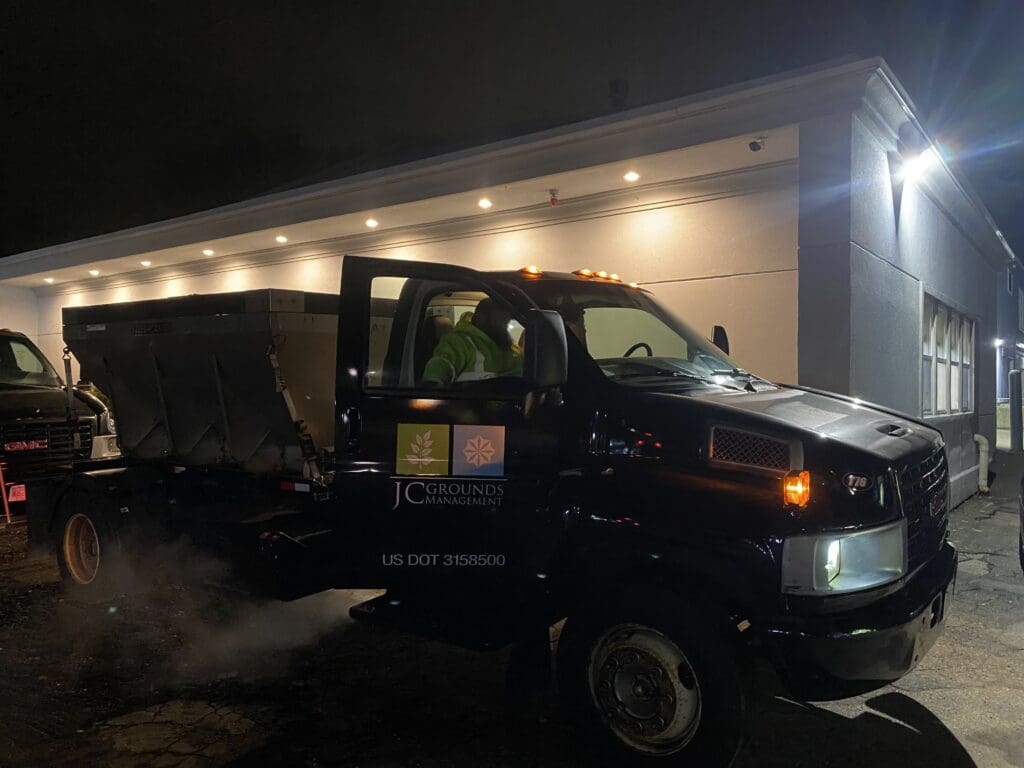
This winter has marked the return of snow for many landscape contractors after a considerable drought. One of the workhorses of the snow and ice management business is salt, as it can lower the freezing point of water, but overuse of this material can be hazardous to the environment.
As you reflect on the 2024 snow season and consider ways to improve your operations from an economic and environmental point of view, review your current salt usage and if any of your practices need to be adjusted.
Review Your Contracts
Phill Sexton, CEO and founder of WIT Advisers, says in more southern snow markets, landscape contractors are often paid by time and material, so this is incentivizing salt waste. He says one of the first steps in the Sustainable Winter Management (SWiM) program requires performance-based rather than quantity-based (i.e. T&M) contracts.

“As soon as you change the contract model to be something other than time and material or a per application, suddenly we as contractors look at it very differently,” Sexton says. “Now it’s about being efficient. Now it’s about using as little material as possible to still achieve the same result, which we know is possible.”
Sexton says changing these contracts is a problem in the Mid-Atlantic due to the infrequency of snow events.
“If I’m the client, why would I pay any other way?” Sexton says. “If I’m the contractor, though, I’m getting pretty close to I can’t afford to do it this way anymore because you, the client, are expecting me to be ready for Snowmageddon and have all the equipment. You’re expecting me to be a fire department with all the resources ready to go, but I have no way of paying for it unless it snows. It’s like I’m a fire department that only gets paid if there’s a fire.”
Jonathan Crandall, chief visionary with JC Grounds Management, based in Danvers, Massachusetts, says this issue has already been addressed in the Boston market. Back in the day, salt used to be priced out per ton.
“It was incentivized for the contractor to use more salt,” Crandall says. “Today, typically, you’re selling it as a service, as a treatment. I think that’s good because it’s moving us in the right direction, where there’s incentives to be more efficient, not less efficient.”
The Benefits of Brining
Crandall says that pre-treatment is a necessity when reducing salt usage as it creates a safer surface.
“Using a liquid product like brine for pre-treatment will help in the reduction of salt,” Crandall says. “Generally speaking, we use brine whenever we can, because you’re going to use somewhere in the range of 50% to 70% less sodium chloride when you use brine.”
Sexton says that anti-icing practices play a huge role in preventing the bond during a snow event. Contractors have more control of the application rate and application coverage with direct liquid applications. The material is not bouncing and scattering like solid salt granules.
Sexton compares the parking lot to a frying pan. When you prevent the bond, it’s far easier to scrape the snow off, just like it’s easier to clean up a non-stick frying pan. Sexton estimates operators are saving about 20% in operating costs when they brine before a snow event.
“Where we’ve deployed Sustainable Winter Management (SWiM®) standards, we’ve actually found, yes, you may actually reduce your top-line revenue, but for the actual work and materials that you’re using, we actually find that there’s an increase in profitability, the bottom line,” Sexton says. “What is the number you’re really worried about? The top or the profit? To me, it’s all about the profit. So why wouldn’t you concentrate on that? That’s really what this is about.”
Sexton notes that the industry gets frustrated with brine because it has been oversold.
“The only thing it’s meant to do is prevent the bonding so that you get a clean scrape,” Sexton says.
He adds that anti-icing is also beneficial with reducing slip and fall incidents.
“If you anti-ice and snow accumulates on top of it, it still creates a slush layer beneath it though, not an ice layer,” Sexton says.
Educating Clients
Another big driver for the overuse of salt during snow events is customer demand. Crandall says they often have clients say they want more salt, and they have to constantly educate the customer there is a point of diminishing return when it comes to using salt.

“If it’s a retail client and somebody slips out in the lot, the first thing they do is coming inside of the store and say, ‘Your lot’s unsafe,’ and that’s when people get the phone calls of ‘You need to apply more salt,’” Crandall says. “The operator may have just come through and applied it. Sometimes the manager won’t care. They’ll say, ‘Well, we know you applied it, but we want you to reapply. It’s not enough.’ As an expert in the industry, I can sit there and tell the manager, ‘Listen, we applied it. It is going to do its job. It’s going to take a little bit of time, but you just need to allow it to do its thing,’ and that’s the last thing they want to hear half the time.”
During the selling phase, build rapport with your clients. Crandall says they share a lot about how they measure and calculate how much material to use per acre.
Sexton says to shift customer mindsets’ you typically need to focus on their pain points and increase their awareness.
“I think for us as contractors, if we really want to be doing the right thing for our clients, how do we create this awareness in a way that’s relatable to the client?” Sexton says. “They’re just thinking slip and fall liability, so more must be better.”
Often customers perceive visible salt granules on the ground a high level of service or safety, but you need them to understand what they’re looking at is actually waste. Sexton adds that when you overconcentrate salt on the surface, it can create freezing conditions rather than melting. You are essentially making ice cream.
“There is a business decision you have to make sometimes where if a customer’s completely adamant no matter how much you tell them, they still want you to do it,” Crandall says. “It’s up to the contractor at this point in time to make the decision of should I just appease them and put more material down? Or am I going to move on from this client at some point because they’re being irrational?”
From a practical level, excess salt causes floor damage, metal to rot, and issues with escalators and elevators.
“Property managers usually know a lot about the building,” Sexton says. “They don’t know a lot about the exterior and they don’t understand that a lot of their problems are actually being caused by the salt in their building. For every couple of bucks of salt that I have to use up by the doorway, it’s causing them $50 or more of cleanup every time.”



